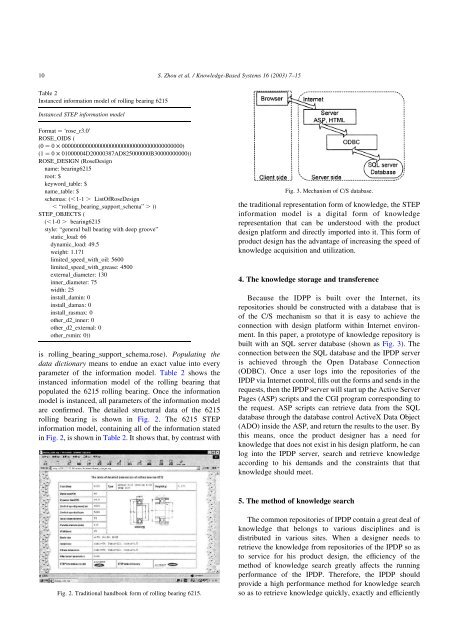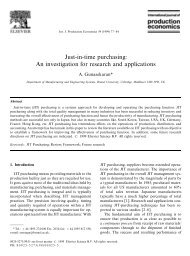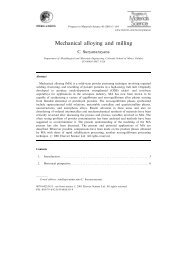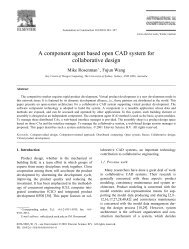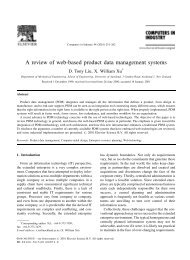Internet-based intensive product design platform for ... - GRACO
Internet-based intensive product design platform for ... - GRACO
Internet-based intensive product design platform for ... - GRACO
Create successful ePaper yourself
Turn your PDF publications into a flip-book with our unique Google optimized e-Paper software.
10<br />
Table 2<br />
Instanced in<strong>for</strong>mation model of rolling bearing 6215<br />
Instanced STEP in<strong>for</strong>mation model<br />
Format ¼ ‘rose_r3.0’<br />
ROSE_OIDS (<br />
(0 ¼ 0 £ 0000000000000000000000000000000000000000)<br />
(1 ¼ 0 £ 01000004D20000387AD825000000B30000000000))<br />
ROSE_DESIGN (RoseDesign<br />
name: bearing6215<br />
root: $<br />
keyword_table: $<br />
name_table: $<br />
schemas: (,1-1 . ListOfRoseDesign<br />
, “rolling_bearing_support_schema” . ))<br />
STEP_OBJECTS (<br />
(,1-0 . bearing6215<br />
style: “general ball bearing with deep groove”<br />
static_load: 66<br />
dynamic_load: 49.5<br />
weight: 1.171<br />
limited_speed_with_oil: 5600<br />
limited_speed_with_grease: 4500<br />
external_diameter: 130<br />
inner_diameter: 75<br />
width: 25<br />
install_damin: 0<br />
install_damax: 0<br />
install_rasmax: 0<br />
other_d2_inner: 0<br />
other_d2_external: 0<br />
other_rsmin: 0))<br />
is rolling_bearing_support_schema.rose). Populating the<br />
data dictionary means to endue an exact value into every<br />
parameter of the in<strong>for</strong>mation model. Table 2 shows the<br />
instanced in<strong>for</strong>mation model of the rolling bearing that<br />
populated the 6215 rolling bearing. Once the in<strong>for</strong>mation<br />
model is instanced, all parameters of the in<strong>for</strong>mation model<br />
are confirmed. The detailed structural data of the 6215<br />
rolling bearing is shown in Fig. 2. The 6215 STEP<br />
in<strong>for</strong>mation model, containing all of the in<strong>for</strong>mation stated<br />
in Fig. 2, is shown in Table 2. It shows that, by contrast with<br />
Fig. 2. Traditional handbook <strong>for</strong>m of rolling bearing 6215.<br />
S. Zhou et al. / Knowledge-Based Systems 16 (2003) 7–15<br />
Fig. 3. Mechanism of C/S database.<br />
the traditional representation <strong>for</strong>m of knowledge, the STEP<br />
in<strong>for</strong>mation model is a digital <strong>for</strong>m of knowledge<br />
representation that can be understood with the <strong>product</strong><br />
<strong>design</strong> <strong>plat<strong>for</strong>m</strong> and directly imported into it. This <strong>for</strong>m of<br />
<strong>product</strong> <strong>design</strong> has the advantage of increasing the speed of<br />
knowledge acquisition and utilization.<br />
4. The knowledge storage and transference<br />
Because the IDPP is built over the <strong>Internet</strong>, its<br />
repositories should be constructed with a database that is<br />
of the C/S mechanism so that it is easy to achieve the<br />
connection with <strong>design</strong> <strong>plat<strong>for</strong>m</strong> within <strong>Internet</strong> environment.<br />
In this paper, a prototype of knowledge repository is<br />
built with an SQL server database (shown as Fig. 3). The<br />
connection between the SQL database and the IPDP server<br />
is achieved through the Open Database Connection<br />
(ODBC). Once a user logs into the repositories of the<br />
IPDP via <strong>Internet</strong> control, fills out the <strong>for</strong>ms and sends in the<br />
requests, then the IPDP server will start up the Active Server<br />
Pages (ASP) scripts and the CGI program corresponding to<br />
the request. ASP scripts can retrieve data from the SQL<br />
database through the database control ActiveX Data Object<br />
(ADO) inside the ASP, and return the results to the user. By<br />
this means, once the <strong>product</strong> <strong>design</strong>er has a need <strong>for</strong><br />
knowledge that does not exist in his <strong>design</strong> <strong>plat<strong>for</strong>m</strong>, he can<br />
log into the IPDP server, search and retrieve knowledge<br />
according to his demands and the constraints that that<br />
knowledge should meet.<br />
5. The method of knowledge search<br />
The common repositories of IPDP contain a great deal of<br />
knowledge that belongs to various disciplines and is<br />
distributed in various sites. When a <strong>design</strong>er needs to<br />
retrieve the knowledge from repositories of the IPDP so as<br />
to service <strong>for</strong> his <strong>product</strong> <strong>design</strong>, the efficiency of the<br />
method of knowledge search greatly affects the running<br />
per<strong>for</strong>mance of the IPDP. There<strong>for</strong>e, the IPDP should<br />
provide a high per<strong>for</strong>mance method <strong>for</strong> knowledge search<br />
so as to retrieve knowledge quickly, exactly and efficiently


